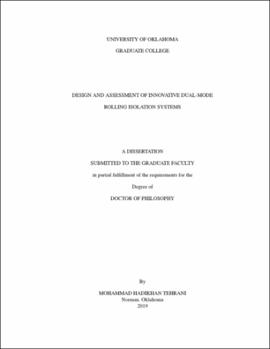| dc.description.abstract | Loss of operation or devastating damage to buildings and industrial structures, as well as equipment housed in them, has been observed due to earthquake-induced vibrations. A common source of operational downtime is due to the performance reduction of vital equipment, which are sensitive to the total transmitted acceleration. A well-known method of protecting such equipment is seismic isolation of the equipment itself (or a group of equipment), as opposed to the entire structure due to the lower cost of implementation. The first objective of this dissertation is assessing a rolling isolation system (RIS) based on existing design guidelines for telecommunications equipment. A discrepancy is observed between the required response spectrum (RRS) and the one and only accelerogram recommended in the guideline. Several filters are developed to generate synthetic accelerograms that are compatible with the RRS. The generated accelerograms are used for probabilistic assessment of a RIS that is acceptable per the guideline. This assessment reveals large failure probability due to displacement demands in excess of the displacement capacity of the RIS. When the displacement demands on an isolation system are in excess of its capacity, impacts result in spikes in transmitted acceleration. Therefore, the second objective of this dissertation is to design impact prevention/mitigation mechanisms. A dual-mode system is proposed where the behavior changes when the displacement exceeds a predefined threshold. A new piecewise optimal control approach is developed and applied to find the best possible mechanism for the region beyond the threshold. By utilizing the designed curves obtained from the proposed optimal control procedure, a Kelvin-Voigt device is tuned for illustrative purposes.
On the other hand, the preference for protecting equipment decreases as the earthquake intensity increases. In extreme seismic loading, the response mitigation of the primary structure (i.e., life safety and collapse prevention) is of greater concern than protecting isolated equipment. Therefore, the third objective of this dissertation is to develop an innovative dual-mode system that can behave as equipment isolation under low to moderate seismic loading and passively transition to behave as a vibration absorber for the primary structure under extreme seismic loading. To reduce the computational cost of simulating a large linear elastic structure with nonlinear attachments (i.e., equipment isolation with cubic hardening nonlinearity), a reduced order modeling method is introduced that can capture the behavior of such nonlinear coupled systems. The method is applied to study the feasibility of dual-mode vibration isolation/absorber. To this end, nonlinear transmissibility curves for the roof displacement and isolated mass total acceleration are developed from the steady-state responses of dual-mode systems using the harmonic balanced method. The final objective of this dissertation is to extend
the reduced order modeling method developed for linear elastic structure with nonlinear attachment to inelastic structures (without attachments). The new inelastic model condensation (IMC) method uses the modal properties of the full structural model (in the elastic range) to construct a linear reduced order model in conjunction with a hysteresis model to capture the hysteretic inter-story restoring forces. The parameters of these hysteretic forces are easily tuned, in order to fit the inelastic behavior of the condensed structure to that of the full model under a variety of simple loading scenarios. The fidelity of structural models condensed in this way is demonstrated via simulation for different ground motion intensities on three different building structures with various heights. The simplicity, accuracy, and efficiency of this approach could significantly alleviate the computational burden of performance-based earthquake engineering. | en_US |
